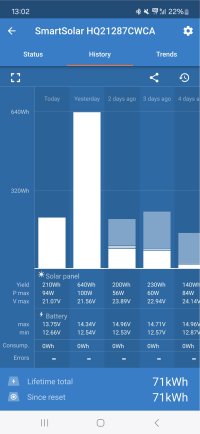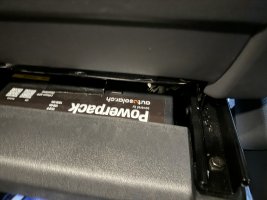Norfolk Jim
Finally retired at last.....................
Lifetime VIP Member
Wow. That's a lot going on and over my head lol.Hi Jim,
i have pondered the same question myself since getting our Cali New Year. Lots of conflicting priorities and considerarions.
After much pondering, my solution is an Anker C1000 Solar generator (£700) that fits perfectly between the front seats and 2 x All Powers 200w folding panels (I actually bought 1 when on sale in January for £180 but they sent me 2 !) the C1000 has an 1800w pure sinwave inverter that powers my kettle or air fryer no problem and charges fully from empty in about 4 hrs on an average sunny day from empty with my 400w of foldable solar that i position optimally regardless of how the van is orientated.
- We sometimes have roof bars in place for a roof box (we have 2 teenage daughters and have to take a tent and all their beautification products when we go on a longer holiday)
- Orientation and shade on site (wifes priority) conflict with best van placement for roof solar production.
- plugging in on the driveway is not a problem where we live.
- I sometimes use the Cali for work and like to have 240v (900w air fryer and 1000w kettle) but EHU is not always an option.
I have a male to male cigarette lighter cable that i use from the regulated 10 Amp socket on the C1000.(not bidirectional) that i connect to one of the rear cigarette lighter sockets in the Cali to trickle charge the leisure batteries when on site- this just ablut keeps up with fridge use once cooled down and not running the compressor all the time.
If the leisure batteries get a bit low after a long time off EHU I can use my 3 pin 13 Amp to EHU tail to connect the C1000 AC to the Cali EHU socket (Cali thinks it is on EHU so charges the leisure batteries). The Anker C1000 will charge from solar at the same time as powering the Cali.
When travelling, I can charge the C1000 from the 12v cigarette lighter socket to get about 120w (slow but ok on a long journey) if i am on a shorter journey i can limit the AC charging on the C1000 to 200w and connect it to the Cali AC inverter (not the most efficient but the Cali alternator has plenty of capacity in hand to charge the leisure batteries whilst discharging via the inverter).
This solution works well for me, provides lots of flexability, and if i dont even consider the 200w pannel i got for free, provides all the flexability for a similar cost to having 200w of permenant solar fitted on my roof.
I think my use will be at the simplest end of solar


















